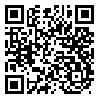Volume 8, Issue 20 (8-2021)
2021, 8(20): 129-153 |
Back to browse issues page
Download citation:
BibTeX | RIS | EndNote | Medlars | ProCite | Reference Manager | RefWorks
Send citation to:



BibTeX | RIS | EndNote | Medlars | ProCite | Reference Manager | RefWorks
Send citation to:
vaez B, nasri A. Rereading Two Travelogues of Qajar Era Based on Systemic Functional Linguistics of Halliday at Ideational Metafunction Level. Journal title 2021; 8 (20) :129-153
URL: http://jls.khu.ac.ir/article-1-1942-en.html
URL: http://jls.khu.ac.ir/article-1-1942-en.html
1- Allameh Tabataba’i University , batulvaez@yahoo.com
2- Allameh Tabataba’i University
2- Allameh Tabataba’i University
Abstract: (4448 Views)
Systemic functional linguistics of Halliday is one of semantic approaches to the analysis and interpretation of literary texts as opposed to structural linguistics. In the present study, we have examined the applicability of this theory at the level of ideational metafunction to reread the style of the text of two travelogues of the Qajar era and to differentiate between language functions in both feminine and masculine styles through how they are represented in verb processes. The main question of this research is how to represent the experiences and observations of two authors during the journey through the transient structure formed in the processes that have depicted the experimental world of the two travelogues. By selecting similar parts in each travelogue, we examined five hundred process samples. After determining the type of each process and its statistics, we compared the frequency of the function of each of the six processes (material, mental, relational, verbal, behavioral, and existential) at the level of ideational metafunction. The results showed the higher frequency of the mental process in the Qajar lady’s travelogue, and the higher frequency of the relational process in the unknown man travelogue, respectively, indicating the greater attention of the Qajar lady to the inner world, and the greater importance of discovering relationships in the world around and evaluation of these relations in the mind and language of the male author. Through our examining the use of marginal additions in the two travelogues, it became clear that Sakineh Sultan used these additions 27% more than the unknown man in the text, which shows her paying more attention to recording details during the trip. In terms of the use of various marginal additions, the addition of place and accompaniment in the male author’s travelogue and the addition of degree, quality, intention, and cause in the female author’s travelogue are more frequent. This shows style differences in the two writings regarding the formation and depiction of outside world experiences in the mind and their representation manner in the language of these two authors. In terms of transitive structure in these two travelogues, wherever the writers are preparing the ground for expressing the main point, the sentences are less transient and wherever an important event and speech is presented, the degree of transientness of the sentences is higher. This means that verb processes in the foreground of the speech have more participants, are voluntary and positive, have real face, with high agency and ultimate appearance, and individuality is object and the degree of the object’s being influenced is more than the sentences in the background of the speech.
Keywords: Functional Linguistics, Ideational Metafunction, Transient Structure, Verb Processes, Marginal Additions, Feminine and Masculine Style, Travelogue
References
1. آقاگلزاده، فردوس (1390) تحليل گفتمان انتقادي. تهران: علمي و فرهنگي.
2. ايشاني، طاهره (1393) «بررسي ويژگيهاي سبکي و شخصيتي سيمين دانشور با رويکرد زبانشناسي نقشگرا». زبانشناخت. سال پنجم. شمارة 1: 19-34.
3. ايشاني، طاهره و زينب برزگري (1398) «بررسي سنجشي مضمون و سبک در حکايات و حکمتهاي گلستان و بهارستان براساس کارکرد تجربي فرانقش انديشگاني». علم زبان. دورة ششم. شمارة 10: 325-356.
4. پهلواننژاد، رضا و آزاده نجفي (1387) «اهميت نقش ارتباطي زبان در جهت فرآيند زبانآموزي در کودکان دبستاني». نوآوريهاي آموزشي. سال هفتم. شمارة 28: 47-74.
5. راسخمهند، محمد، و مسعود محمديراد (1394) «تأثير گذرايي بر ساخت جمله در زبان فارسي». پژوهشهاي زبانشناسي تطبيقي. سال پنجم. شمارة 9: 1-47.
6. رضويان، حسين، و شيوا احمدي (1395) «نگاهي به نقش جنسيت نويسنده در ارائة جزئيات در داستان براساس دستور نقشگرا». جستارهاي زباني. دورة هفتم. شمارة 6: 343-370.
7. سفرنامة عتبات (1391) تصحيح و تحقيق سيد خليل طاووسي. پيام بهارستان. شمارة 15: 319-393.
8. سکينه سلطان (وقارالدوله) (1317 ق) خانوم فردا کوچ است. ويرايش و تدوين زهرا صالحيزاده. تهران: اطراف.
9. صدري، نيره (1394) «بررسي سبکشناختي گلستان سعدي با تکيه بر زبان¬شناسي نقشگرا». رسالة دکتري دانشگاه علامه طباطبايي.
10. صفايي، مژگان، سيدمحمدرضا عادل، محمود رمضانزاده لک (1396) «بررسي و تحليل فرآيندهاي فرانقش انديشگاني در شعر «کسي که مثل هيچکس نيست» اثر فروغ فرخزاد در چارچوب نظرية نقشگراي هليدي». شعرپژوهي. سال نهم. شمارة 2: 17-140.
11. طاهري، قدرت¬الـله (1388) «زبان و نوشتار زنانه؛ واقعيت يا توهم؟». زبان و ادب پارسي. شمارة 42: 87-107.
12. عزيزخاني، مريم، سيدرضا نجفي سليمانزاده، نصراللـه شاملي (1396) «کاربست دستور نقشگراي هليدي بر سورة انشراح». پژوهشهاي ادبي- قرآني. سال پنجم. شمارة 4: 69-94.
13. مشکوهالديني، مهدي (1395) سير زبان¬شناسي. چاپ هفتم. مشهد: دانشگاه فردوسي مشهد.
14. فالر، راجر (1381) ادبيات بهمنزلة کلام، زبان¬شناسي و نقد ادبي. ترجمة مريم خوزان و حسين پاينده. ويراست دوم. تهران: ني.
15. مهاجر، مهران و محمد نبوي (1393) بهسوي زبانشناسي شعر. تهران: آگه.
16. وفايي، عباسعلي، و فرشته ميلادي (1399) «بررسي جايگاه تجربهگر در نظام فکري اشراقي برمبناي فرانقش انديشگاني (مطالعة موردي: رسائل لغت موران و صفير سيمرغ)». ادبيات عرفاني و اسطورهشناختي. سال شانزدهم. شمارة 59: 271-296.
17. هليدي، مايکل و رقيه حسن (1395) زبان، بافت و متن. ترجمة مجتبي منشي¬زاده و طاهره ايشاني. چاپ دوم. تهران: علمي.
18. Thompson.Geoff (2004) Introducing Functional Grummar. 2nd ed. London: Arnold Publication.
19. Halliday, Michael and Matthiessen Christian (2004) Introduction to Functional Grammar.3rd ed. Hodder Arnold Pub.
20. Hopper, Paul J. & Sandra A. Thompson) 1980( "Transitivity in grammar and discourse". Language, 56: 251-299. [DOI:10.1353/lan.1980.0017]
Send email to the article author
| Rights and permissions | |
 | This work is licensed under a Creative Commons Attribution-NonCommercial 4.0 International License. |







